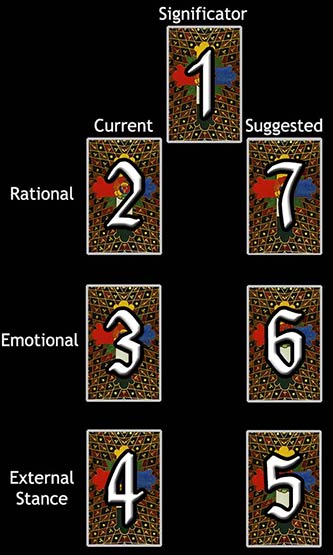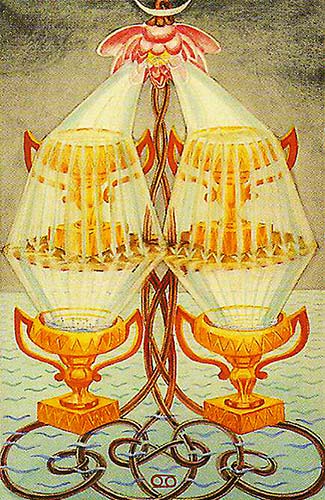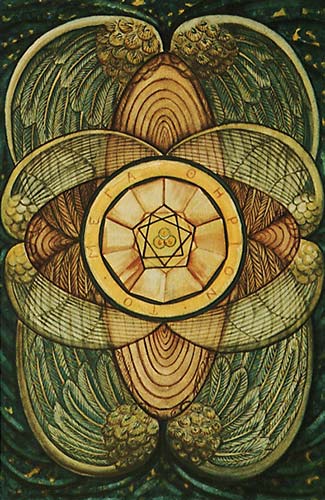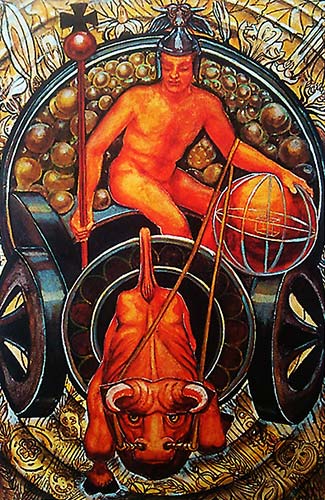Path Spread

Difficulty: Easy
For the Path, the querent asks for suggestions on how to behave properly in order to achieve a desired result. The Current column shows how the querent has been acting, and the Suggestedcolumn suggests how the querent should act in order to achieve a certain goal. The chart-like spread uses the standard 3 levels: Rational, Emotional, and External Stance (how one projects one’s self outwardly). When comparing the Current to Suggested cards, the most important thing is to notice the differences between the 2 cards. It is these differences which hint at the behaviors that you should think about changing.
Card #1 is the significator, the card which should reflect the nature of the query and/or the desired outcome.
Card #2 shows the way you are and have been thinking. Card #7 shows how you need to change the way you think in order to serve yourself better.
Card #3 tells you about your emotional attitude. Though it may seem difficult to manipulate one’s own emotions, it can be done if you put your mind to it. For example, acting a certain way such as smiling intently for a few minutes will lead the emotions to follow. If you try this, as silly as the exercise seems, you will find that this evokes the emotion of happiness. For this reading, you should try to make yourself feel the way that Card #6 tells you.
External Stance means how you act outwardly, how you hope others see you. Card #4 tells you how you were acting, while #5 indicates how you should act outwardly, for other people’s sake. It is the differences between these cards that hint at what behavior patterns should be altered.
Your Path Reading with the Thoth Tarot
Current |
The Significator  6 of Cups |
Suggested |
|
Thought |
 7 of Disks |
 4 of Cups |
|
Emotion |
 Knight of Disks |
 Ace of Disks |
|
External Stance |
 The Devil |
 Prince of Disks |

The Significator
6 of Cups
Sun in Scorpio – Pleasure
This card shows the influence of the number Six, Tiphareth, in the suit of Water. This influence is fortified by that of the Sun, who also represents the Six. The whole image is that of the influence of the Sun on Water.
The lotus stems are grouped in an elaborate dancing movement. From their blossoms water gushes into the Cups, but they are not yet full to overflowing, as they are in the corresponding card below; the Nine. Pleasure, in the title of this card, must be understood in its highest sense: it implies well-being, harmony of natural forces without effort or strain, ease, satisfaction. Foreign to the idea of the card is the gratification of natural or artificial desires. Yet it does represent emphatically the fulfilment of the sexual Will, as shown by the ruling Sephira, planet, element, and sign.

Current Thoughts
7 of Disks
Saturn in Taurus – Failure
The number Seven, Netzach, has its customary enfeebling effect, and this is made worse by the influence of Saturn in Taurus. The disks are arranged in the shape of the geomantic figure Rubeus, the ugliest and most menacing of the Sixteen. The atmosphere of the card is that of Blight. On the background, which represents vegetation and cultivation, everything is spoiled. The four colours of Netzach appear, but they are blotched with angry indigo and reddish orange. The disks themselves are the leaden disks of Saturn. They suggest bad money.

Suggested Thoughts
4 of Cups
Moon in Cancer – Luxury
This card refers to Chesed in the sphere of Water. Here, below the Abyss, the energy of this element, although ordered, balanced and (for the moment) stabilised, has lost the original purity of the conception. The card refers to the Moon in Cancer, which is her own house; but Cancer itself is so placed that this implies a certain weakness, an abandonment to desire. This tends to introduce the seeds of decay into the fruit of pleasure.
The sea is still shown, but its surface is ruffled, and the four Cups which stand upon it are no longer so stable. The Lotus from which the water Springs has a multiple stem, as if to show that the influence of the Dyad has gathered strength.

Current Emotions
Knight of Disks
Virgo
The Knight of Disks represents the fiery part of Earth, and refers in particular to the phenomena of mountains, earthquakes, and gravitation; but it also represents the activity of Earth regarded as the producer of Life. This warrior is short and sturdy in type. He rides through the fertile land; even the distant hills are cultivated fields.
Those whom he symbolises tend to be dull, heavy and pre-occupied with material things. They are laborious and patient, but would have little intellectual grasp even of matters which concern them most closely. Their success in these is due to instinct, to imitation of Nature. They lack initiative; their fire is the smouldering fire of the process of growth.

Suggested Emotions
Ace of Disks
The Root of Earth
The Ace of Disks pictures the entry of that type of Energy which is called Earth. About this whirling Disk are its six Wings; the entire symbol is not only a glyph of Earth as understood in this New Aeon of Horus, but of the number 6, the number of the Sun. This card is thus an affirmation of the identity of Sol and Terra.

Current External Stance
The Devil
Capricorn
Blind impulse, irresistibly strong and unscrupulous, ambition, temptation, obsession, secret plan about to be executed; hard work, obstinacy, rigidity, aching discontent, endurance.

Suggested External Stance
Prince of Disks
Taurus
The Prince of Disks represents the airy part of Earth, indicating the florescence and fructification of that element. The figure of this Prince is meditative. He is the element of Earth become intelligible. In his left hand he holds his disk, which is an orb resembling a globe, marked with mathematical symbols as if to imply the planning involved in agriculture. In his right hand he bears an orbed sceptre surmounted by a cross, a symbol of the Great Work accomplished.
A steadfast and per severing worker, he is competent, ingenious, thoughtful, cautious, trustworthy, imperturbable. He constantly seeks new uses for common things, and adapts his circumstances to his purposes in a slow, steady, well-thought-out plan. He is lacking almost entirely in emotion. He is somewhat insensitive, and may appear dull, but he is not; it so appears because he makes no effort to understand ideas which are beyond his scope. He may often appear stupid, and is inclined to be resentful of more spiritual types. He is slow to anger, but, if driven, becomes implacable.